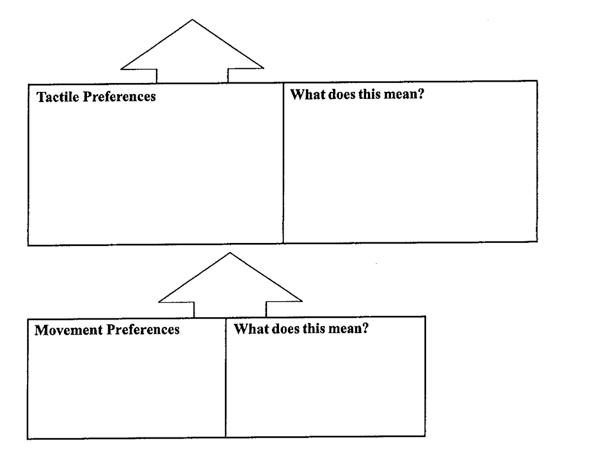-

Preparing Youth with Autism Spectrum Disorder for Adulthood A Transition Toolkit for Educators
UNIT 3.4: Sensory Self-Regulation
Key Questions
- What is sensory self-regulation?
- Why is training in sensory self-regulation needed?
- Can all youth with ASD learn sensory self-regulation?
- When should I start teaching sensory self-regulation?
- How do I know what to teach?
- How can I teach my students sensory self-regulation?
Appendices
- Appendix 3.4A: Online and Other Resources
- Appendix 3.4B: Sensory Support
- Appendix 3.4C: Supplemental Instructional Materials
- Appendix 3.4D: Glossary of Terms
By Helen Clarke
This unit provides information and practical, accessible resources for best practice supports for youth and young adults with ASD in transition services and activities, including instruction. Given the diversity in this population, educational staff may not always feel adequately prepared to provide the necessary supports to youth with ASD. Each member of the transition planning team will bring specialized training and experiences to the knowledge base. The information and resources in this unit is designed to help supplement the collective knowledge of the transition IEP team. Additional training or consultation may be needed.
This is a resource for you and is designed so that you can return to sections of this unit as you need more information or tools. You do not need to read this unit from beginning to end or in order. Links to questions, appendices and online resources are provided so that you can go directly to what is most relevant to you at the time.
What is sensory self-regulation?
Sensory regulation is the ability to attain, maintain, and change arousal levels appropriately for a task or situation. Adequate regulation can also be referred to as the “just right state” (Williams and Shellenberger, 1994). The “just right state” varies throughout the day and for different activities. For example, the arousal level one has first thing in the morning may be low but by drinking coffee, going for a run or taking a shower one can bring ones arousal level up to start the day. The “just right state” in a church or classroom is calm and quiet, but it is appropriate to have a higher arousal level when watching sports or at a party.
Sensory Self Regulation is the ability to control one's level of arousal and activity state and respond appropriately to sensory input without staff support or prompting. It requires being aware of one’s own sensory needs in everyday settings and situations, and knowing how to use techniques to meet those needs appropriately. Sensory self-regulation occurs when one can perceive their own bodies as separate from the environment, analyze, organize, and connect (integrate) sensory messages, and respond to sensory information in a meaningful and consistent way. For example, person with sensory self regulation may eat lunch in a loud cafeteria then use strategies to calm and quiet his body before transitioning to the classroom where he is expected to be calm and quiet. Hearing a fire truck drive by may distract him for a few seconds but then he is able to use calming strategies to turn his attention back to the task at hand.
Below are the seven sensory systems and their functions from Aspy and Grossman (2008).
Why is training in sensory self-regulation needed?
Impairment to the sensory system is a core characteristic of ASD. Self-regulation difficulties of youth and young adults with ASD can not only create frustration and anxiety, but also may further increase social isolation and impact future employment.
Deficits in sensory integration mean that the brain’s ability to absorb, interpret, or process information received through the senses is limited. People with deficits in sensory information processing often can’t use information obtained through the seven senses efficiently to learn, solve problems, or carry out work responsibilities. They might be unusually sensitive or over-responsive to certain kinds of sensory experiences such as touch, pain, temperature, pressure, or where the body is in space. This difficulty results in frequent frustration, which can lead to work failure.
Youth with disorders of sensory regulation struggle to regulate their emotions, behaviors, and motor abilities in response to sensory stimulation. Everyday sensory information such as touch, sound, and movement may be misinterpreted. The sensory stimulation may come in the form of touch, sight, sound, taste, smell, sensation of movement in space (vestibular), and awareness of the position of one’s body in space (proprioception). These young people may have poor attention, lack of motivation, difficulty understanding situations and difficulty interacting and learning. A youth with poor sensory self-regulation may have difficulty sitting still and irritate his peers, or if his teacher touches his arm to see how he is doing, he may have an adverse reaction. These youth may feel uncomfortable in certain types of clothing or eating certain textures of food. These irritants can cause the person to have negative behaviors in the classroom or work setting or toward others.
Sensory self-regulation is particularly necessary for youth and young adults with ASD who are expected to be independent. An individual's response to sensory input depends on his ability to regulate and understand sensory stimuli and to adjust his emotions to the demands of his surroundings. When youth and young adults do not learn to manage their unique sensory system and achieve self-regulation, they are likely to experience rejection and social disapproval regarding their unregulated behavior. The following provides examples of how sensory disregulation can impact learning and work skills:
- When a student has a hypersensitive/over-responsive sensory system the brain has difficulty filtering out excessive stimuli. Sensory overload causes a “fight, flight, or freeze” reaction (stress response). These individuals may react negatively to a light touch on the arm or someone bumping into them.
- An individual who is hypersensitive/over-responsive to sensory input may have an aversion to being touched, which could lead to serious problems with physical intimacy. This individual may have difficulty waiting in lines or being in close proximity to others.
- When a student has a hyposensitive/under-responsive sensory system the body craves intense sensory input and extra sensory input is needed to notice that their bodies are involved in the activities. These individuals may bang into items or people in order to get the input to their bodies. Hyposensitive individuals may hum or make other noises to help keep their arousal level at the “just right state”.
- If an individual who is hyposensitive/under-responsive does not learn to arouse his sluggish systems, he could become one of those workers who chronically runs late and falls short on the job.
- A sensory seeker could end up seeking stimulation from unhealthy sources such as substance abuse, gambling, risk taking or promiscuous behavior.
- Over- or under-responsivity to sensory stimuli can make working in some environments, such as an open-plan office setting, very difficult. Many find it hard to work or maintain a conversation in a noisy environment.
Training in sensory self-regulation can help youth and young adults with different types of sensory challenges in different ways. The under-responsive students can learn to arouse their slow sensory systems; over-responsive students may learn they are best suited to slower paced sit down jobs in quiet settings; and sensory seeking youth who learn self-regulation become good candidates for physically demanding professions that put a premium on speed (Miller, 2006). Those sensory seekers who channel their extraordinary energy into creative and original projects may discover a personal strength that can lead to inventive and entrepreneurial careers. In some professions, the fact that they’re tireless gives them an edge over the competition
Once youth with ASD are able to manage their sensory system sufficiently to maintain the appropriate level of arousal for the task, they can pay attention when they need to and are then able to succeed in their endeavors. This opens educational and career avenues. When students learn to identify their level of alertness and learn what they can do before and/or during stressful times to attain a more optimal state of alertness they are able to engage in tasks. Sensory self-regulation can enable youth and young adults to successfully engage in activities within their home, school, work and community environments (Marr & Nackley, 2006).
Can all youth with ASD learn sensory self-regulation?
Youth with ASD can learn sensory self-regulation to varying degrees. Independence with sensory self-regulation depends upon the cognitive abilities of the youth or young adults and past exposure to sensory techniques.
Sensory self-regulation may not suit youth or young adults with ASD who are the most impacted because of the cognitive demands required to learn and practice self regulation activities. However, there are ways to apply the principles of self-regulation with students with lower cognitive abilities. Youth and young adults who are the most impacted by ASD will need to experience the effect of different sensory techniques and then learn the techniques. Once specific strategies are learned, a student can learn to use a book with pictures of calming activities that he can perform independently. Even then, the youth with ASD may need others to modify the human and nonhuman environment, task demands, and routines to optimize the fit between the student and sensations.
When should I start teaching sensory self-regulation?
Students with ASD should be provided with scheduled experiences of sensory regulation activities from a young age and as they become older they should be taught sensory techniques in preparation for learning sensory self-regulation. Children with severe over-responsivity who have not received effective sensory integration training are likely to continue struggling with sensory sensitivities through middle school and high school because the situations that are most challenging for over-responders- transitions, unpredictability, and sensory overstimulation- reach a crescendo during the teen years. Those children on the spectrum who do not receive timely intervention are at greater risk of reaching adulthood with sensory issues that continue to be disruptive.
How do I know what to teach?
It is important to find strategies that a person with ASD can implement with minimal supervision. Intervention design requires careful attention to the sensory state of the individual and to the sensory demands of environments and activities (Cook, 1990; Myles et al., 2000). An Occupational Therapist trained in sensory processing can provide enormous amounts of assistance in assessment, determining what to teach, and how to teach it.
Formal and informal sensory checklists are available to use to determine the students sensory profile. The Adolescent/Adult Sensory Profile (Brown and Dunn) is designed for formal assessment. This is best completed and interpreted by an Occupational Therapist. Informal sensory checklists completed by student and teacher can give a lot of insight into sensory strengths and weaknesses. Links to free informal sensory checklists, such as the Sensory Modulation checklist, can be found in Appendix 3.4A. Sensory Support Needs for Youth and Young Adults with ASD is provided in Appendix 3.4B to help you determine needed supports for a youth’s sensory challenges.
An ecological survey can be used to collect information about a wide range of variables that can influence a student's problem behavior. It can provide useful information about how the young adult will manage his sensory needs in a variety of environments. (For more information, see Unit 3.8).
Once the assessment is complete using a sensory checklist and ecological inventory, the best techniques for teaching the student sensory self regulation can be determined. The Sensory Team Handbook, Sensory Integration Tools for Teens or How Does Your Engine Run can all help provide appropriate sensory goals and strategies for young adults. See Appendix 3.4C.
How can I teach my student sensory self regulation?
Once the student has been evaluated, general sensory program activities are selected. It is important to explicitly teach sensory self-regulation. Older students need to understand why they need self-regulation (or accommodations), what it's for, how it works, and most of all, why it matters to them. These youths should be taught to take ownership of their sensory issues, understand how their own senses work, have strategies in mind, and take control. Each child has his own mix of hyper- and hyposensitive senses and his own history (Mucklow, 2009).
Sensory Programs
There are a variety of sensory programs commercially available to help the youth with ASD manage their sensory needs. How Does Your Engine Run, The Sensory Team Handbook and the Sensory Integration Tools for Teens books provide lesson plans for the young adult with ASD to learn how to manage their sensory needs. Adjusting the Image has lesson plans for Sensory Self Regulation.
How Does Your Engine Run is a lesson plan that supports students with ASD in choosing appropriate strategies to change or maintain states of alertness. The program uses cognitive-behavioral strategies to teach students to recognize their levels of arousal and to use sensory integrative strategies in order to maintain an optimal level of arousal (Williams & Shellenberger, 1996). See How Does Your Engine Run lesson plans adapted from the curriculum Adjusting the Image in Appendix 3.4C.
The Sensory Team Handbook is a hands-on tool to help young people make sense of their senses and take charge of their sensory processing. It includes checklists, goal setting, education about the brain and body, in relation to sensory and many other hands-on tasks for the youth with ASD (Mucklow, 2009).
Sensory Integration Tools for Teens highlights sensory integration and sensory processing for teens, their parents, teachers and therapists. Topics include understanding the teen brain, the sleepy teen, thrill seeking, drugs, and teen spaces. Healthy age-appropriate alternatives include movement, muscle, ear, and eye tools. The Teen Sensory Tool Survey provides teens with the opportunity to share their sensory preferences and needs with their parents, teachers, and therapists (Henry, 2004).
Strategies
The type of strategies used for teaching sensory regulation depends on the individual’s cognitive level and sensory needs. These strategies may include yoga, relaxation, use of a sensory diet, S’Cool Moves posters for calming or alerting, Sensory Stories and modifications to the environment. A sensory diet should become a regular part of the youth’s routine. Yoga or relaxation can become a life long sensory strategy. Sensory Stories are effective for youth that are more impacted by their ASD. Descriptions of these strategies follow.
Yoga is an excellent medium for students with ASD because it has the potential to meet many of their needs. Yoga helps build strength and flexibility, coordination and balance. It helps youth identify tension within their bodies. Breathing exercises can help them learn to recognize when they are experience agitation and how that feels. Even those students who can’t intellectualize these concepts can feel what is happening to their bodies. (Betts, D. & Betts, S., 2006)
Relaxation can help students with ASD become less anxious and calmer. Relaxation techniques are an essential part of the quest for stress management. Relaxation isn't just about peace of mind or enjoying a hobby. Relaxation is a process that decreases the wear and tear on ones mind and body from the challenges and hassles of daily life. There are different types of relaxation techniques that are beneficial to youth with ASD including progressive relaxation and guided imagery. Progressive relaxation requires the student to learn to tense and release the muscles to feel a calmer state. Guided Imagery is a convenient and simple relaxation technique that can quickly and easily help manage stress and reduce tension in the body.
Sensory Stories are story based sensory strategies used to help the student deal with the unpleasant sensory aspects of a particular situation. When read on a regular basis, Sensory Stories can help the individual to develop effective routines to manage sensory experiences surrounding typical daily activities. Sensory Stories use a variety of self-employed strategies and may be adapted to a specific student’s needs. Appendix 3.4A
S'cool Moves activities include posters of many movement patterns that focus on strengthening auditory, visual, tactile, postural, vestibular, and self-regulation systems of the body. By adding S'cool Moves techniques to techniques already used in daily routines, youth can learn to monitor their own behavior (Wilson & Heiniger-White, 2000).
Sensory Diet is a carefully planned program of specific sensory activities that provides the optimal amount and types of sensation the youth or young adult needs. The sensory diet is based on the theory that controlled sensory input can affect arousal, alertness, and attention level, and thus affect an individual’s ability to function (Wilbarger, 1995). A sensory diet includes proprioception, vestibular and tactile input. It is best to collaborate with older students to identify sensory activities that are age and developmentally appropriate and best meet their sensory needs. An effective sensory diet enables an individual to feel calm, alert, and organized and thus enhances occupational performance. It can also help the student with self-regulation. The Sensory Diet is designed and developed by the Occupational Therapist to specifically meet the unique needs of each youth’s nervous system. An occupational therapist, a classroom teacher, a paraprofessional, a parent or the youth with ASD may implement the Sensory Diet. The Sensory Diet provides the young person with opportunities to receive sensory input at various intervals throughout the day, allowing him to participate more fully in the activities of his daily life. Sensory Diet Activities provides ideas a sensory menu and ideas.
Once the specific sensory activities are chosen, the youth must practice and learn how to do these activities in a variety of settings. The youth with ASD needs to learn how to regulate their sensory system when not under stress first before trying to use those skills out in the environment.
Lastly, it should be determined if the chosen sensory activities are having the desired effect on the youth’s sensory system. This is ongoing as the sensory needs change over time due to maturity, new environmental stressors and changes in the neurological system. (Adapted from Sue Larkey Practical Sensory Programmes for Students with Autism Spectrum Disorder and Other Special Needs)
Appendix 3.4A
Online and Other Resources
- Sensory Self-Regulation
- Assessment and Checklists
- Instructional Materials
- Online Videos
- Online Training
- Practical Books and Videos Available on Loan
- Books
- Video
The resources listed are available at no cost online. While terminology sometimes differs from Website to Website, the basic concepts are the same. Information is either, specific to youth and young adults with ASD or can be adapted for the individual need of the student.
Sensory Self-Regulation
Autism: Reaching for a Brighter Future - Ohio Center for Autism and Low Incidence. This guide offers basic concepts in providing supports for individuals with ASD. It provides comprehensive information related to ASD. Information on Sensory issues, sensory motor processing, and sensory integration are included.
Sensory Processing Disorder Foundation - This site offers information, research, education, and advocacy for Sensory Processing Disorder (SPD).
Assessment and Checklists
Adult Sensory Processing Checklist - Children Foot Clinic. This blog provides a checklist for sensory issues.
Assessing Positive and Negative Reinforcers in Adolescents (13-18) - ABLE-differently. This site provides a self-checklist to assess positive and negative reinforcers.
Free Printable Forms - Sensational Brain. This site provides a sensory checklist, home modifications and school accommodations checklists.
Sensory Diet Exploration: Activity Checklist - This is a checklist of what people may use or do in order to help decrease and/or to prevent distress.
Sensory Modulation Checklist - SPD Life. This site provides a sensory checklist that looks at modulation.
Sensory Over Responsiveness Checklist - SPD Life. This site provides a checklist for over-responsive sensory issues.
SPD Life Sensory Checklist for adults - SPD Life. This site provides a general sensory checklist.
Sensory Integration Checklist - Parent-Child Services Group, Inc.. This site provides a checklist for sensory issues.
Instructional Materials
Alert Program - How Does Your Engine Run?® - Therapy Works Inc. This site for How Does Your Engine Run, a sensory self-regulation curriculum, has some freebies to introduce you to the program.
Autism Relaxation to Decrease Stimming - This autism relaxation script is for helping to decrease stimming. (Repetitive behaviors that stimulate the senses and are used to regulate one’s level of sensory arousal). This guided relaxation script aims to increase ones ability to achieve optimal levels of sensations.
Manual for Adolescents with Asperger’s Piloting Social Success (MAAPSS) - This manual provides a variety of semantic maps and visuals designed to assist in teaching adolescents with high functioning autism various social skills, sensory self-regulation and social thinking concepts. Please go to pdf page 74 Self Advocacy for Sensory.
Practical Autism Resources - This site provides more than 100 pages of free printable items. The stress thermometer and how does your engine run speedometer under Behavior Supports are particularly useful.
Sensory Diet “Menu” Activities and Strategies to Try - Jennifer Dodge. This site provides lists of calming and alerting activities that may be included in a sensory diet.
You Really Need to Learn to Relax: Effective Methods - This article provides techniques for relaxation.
Online Videos
Autism author Stephen Shore talks about sensory issues - This video describes the sensory issues with lights. (1 min.)
Autism and Sensing; The Unlost Instinct - This video is a slideshow from a presentation by bestselling author with ASD, Donna Williams, on autism and sensing. (2 min.)
My Yoga Online - This site provides 5-minute samples of a variety of yoga routines.
Sensory Overload Simulation - This video by a girl with ASD portrays her experience of sensory overload. (3.5 min.)
Sensory Processing Disorder (SPD) Dr. Lucy Jane Miller - This video shows an interview on CBS4 News February 2008 (3.5 min)
SPD on 20-20 Part 1 - This video shows the Sensory Processing Disorder story on 20-20 featuring Dr. Lucy Miller. Part 1 of 2. (5.5 min)
SPD on 20-20 part 2 - This video shows the Sensory Processing Disorder story on 20-20 featuring Dr. Lucy Miller. Part 2 of 2. (5.5 min)
Dr. Stanley Greenspan founder of Floortime speaks - This video shows Dr. Stanley Greenspan, founder of DIR/Floortime speak in an interview from the film "Autistic-Like: Graham's Story". (2 min)
Temple Grandin - Focus on Autism and Asperger's Syndrome - This video discusses early intervention, educational strategies, visual thinking, social skills, medications and mentoring. Sensory issues are also discussed. (1 hr. 13 min.)
What is Sensory Processing Disorder? - This video is a brief animated description of sensory processing disorder for kids. (3 min.)
Online Training
Sensory Differences - Autism Internet Modules. This module provides an overview of the sensory differences that may be present in an individual with ASD and how they may impact their day-to-day behavior and performance.
Practical Books and Videos Available on Loan
Many libraries, including the ones below, have books and videos on sensory and self-regulation for youth with ASD to loan.
Multnomah County Library (MCL)
Reference Line: 503.988.5234
Clackamas County Libraries (CCL)
Library Information Network: 503.723.4888
SRC: Jean Baton Swindells Resource Center for Children and Families
The resources are available to family and caregivers of Oregon and Southwest Washington.
503.215.2429
Below is a list of books and videos on sensory and self-regulation for youth with ASD that can be borrowed from the sources indicated. Check with your library for additional titles.
Books


Videos

Appendix 3.4B
Sensory Support
Content:
- Sensory support Needs for Youth and Young Asults with ASD
- Workplace Implications for Individuals with ASD
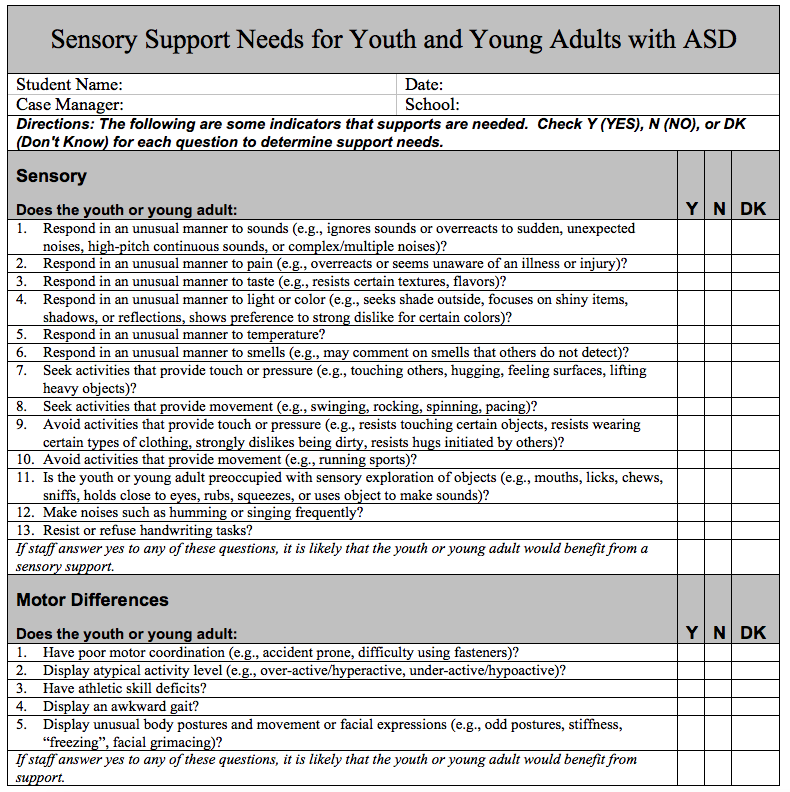
Some items adapted from Underlying Characteristics Checklist-Classic and National Professional Development Center for Autism.
Workplace Implications for Individuals with Autism Spectrum Disorder (ASD)
CHARACTERISTICS OF ASD - SENSORY
Implications Strategies
Individuals with an Autism Spectrum Disorder often have sensitivities to the sensory environment that results in responses and reactions that can be difficult for others in the workplace to understand. These sensitivities can intensify in situations such as:
- Transitions to new environments or people
- Changes in schedules and routines,
- When stressed due to work deadlines, illness, sleep disturbances, or difficulties outside of the workplace.
When assessing a workplace environment or a potential workplace environment, consider the following:
- Will the following sensory issues in the work setting hinder the work performance of the individual with ASD?
- Noise or specific sounds
- Bright or dim lighting
- Smells/Odors
- Visual clutter
- Lack of personal space
- Are there adaptations that could be made to the environment that would reduce or eliminate the sensory challenges? For example:
- Schedule starting time 10 minutes earlier to reduce crowding when entering work site
- Allow extra breaks, as long as efficiency and effectiveness is not compromised
- Provide individual with a strategy such as ear buds with soothing music to help with panic in crowded spaces or unpleasant sounds
- Place the individual in a corner or end desk/work area rather than by a door or in the middle of a group of co-workers
- Use dividers to provide personal space. These may be true office dividers or materials such as file cabinets, room screens, curtains, or bookshelves
- Allow desirable air fresheners or avoid placing the individual near a co-worker that uses heavy perfumes or colognes
- Experiment with different types of lighting. Some work well with natural lighting, some with indirect lighting and some are fine with overhead lights
- Explore opportunities in the workday or the workplace jobs that will allow the person that needs to move or pace to do so in a natural manner. Jobs such as delivering mail or packages, returning items to shelves or bins, greeting co-workers may allow for a natural sensory break. These can also provide the worker with the “heavy work” that can be calming to many individuals.
- Sensory processing challenges and sensitivities will often intensify in stressful situations, unfamiliar routines and with unfamiliar people. Create predictability by using
- visual strategies, such as pictures, video, social scripts,
- clear explanations of what to expect during in the workplace, especially when changes are to occur.
- Could the individual benefit from calming or alerting activities to deal with those sensory issues that remain?
Appendix 3.4C
Supplemental Instructional Materials
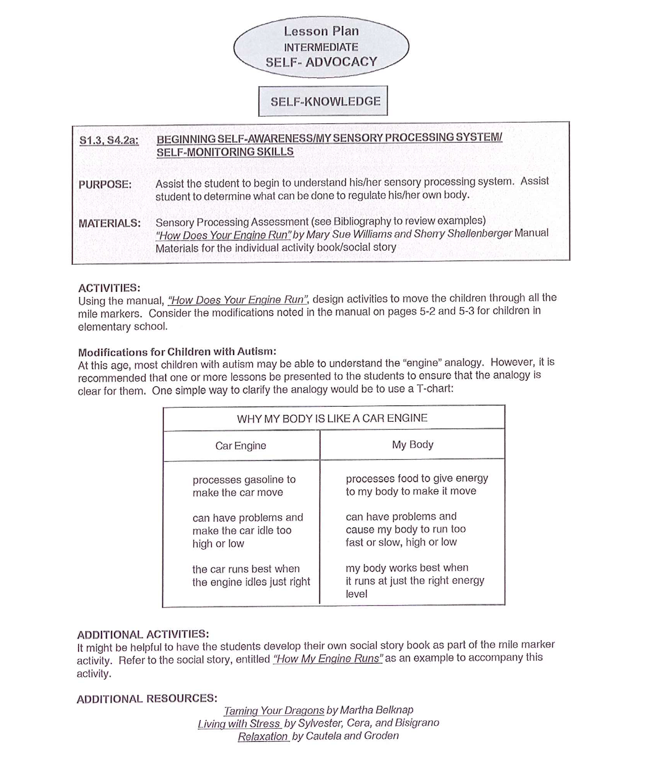

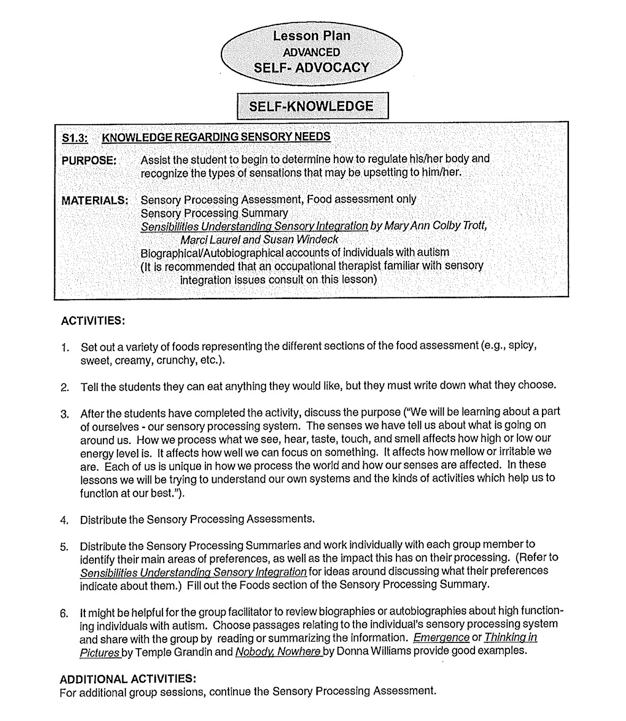

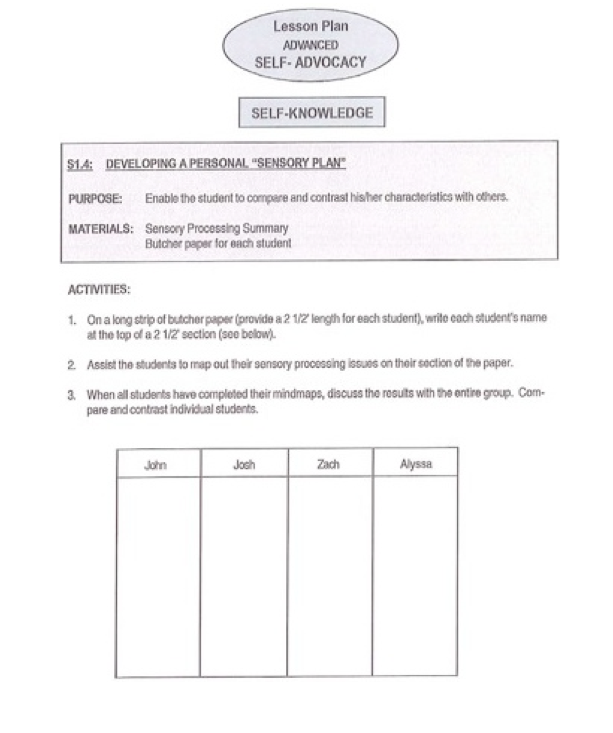

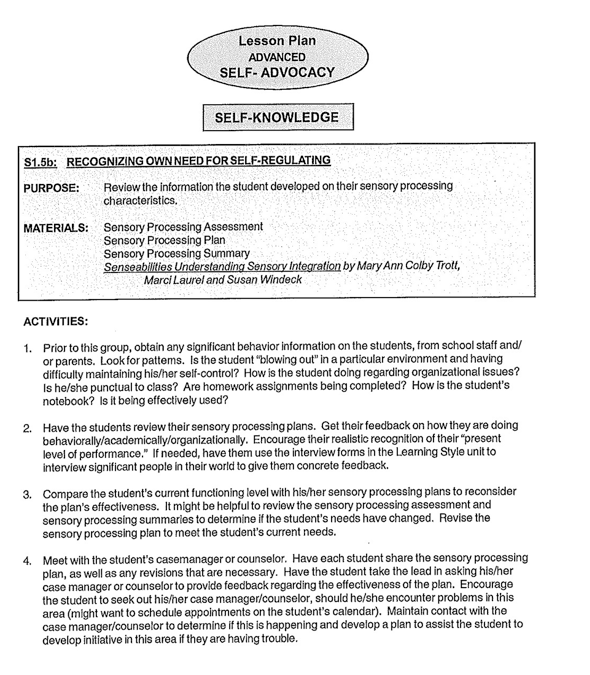

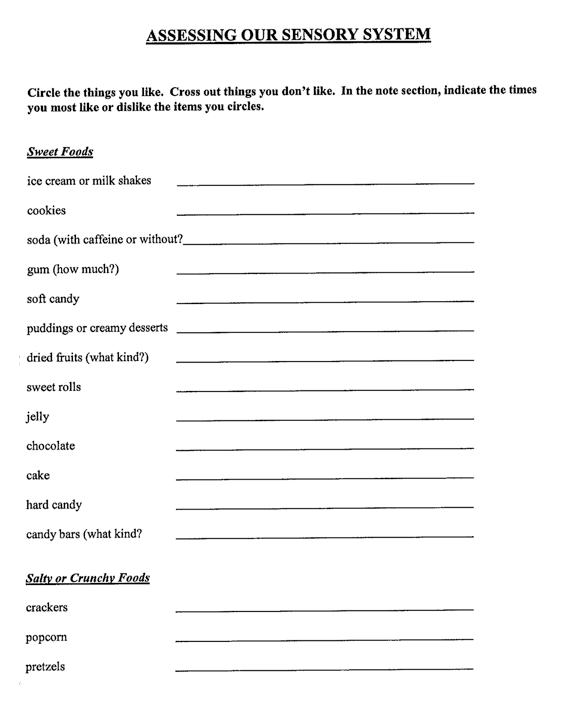

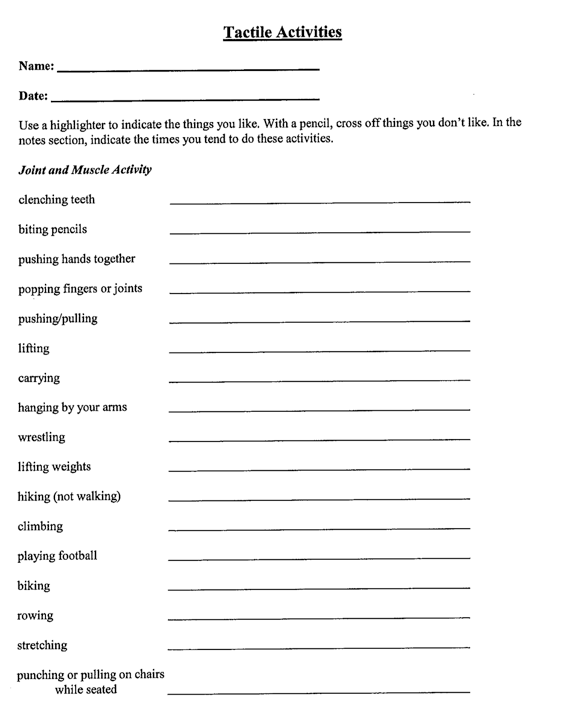

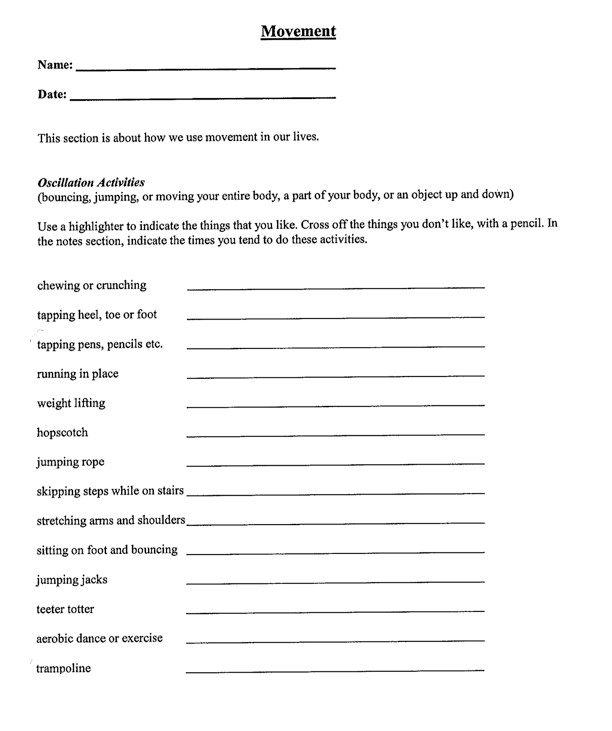



Appendix 3.4D
Glossary of Terms
Auditory/Sound. Gathers information from sounds in the environment
Cognitive Behavioral Approach is an approach that aims to solve problems concerning dysfunctional emotions, behaviors and cognitions through a goal-oriented, systematic procedure.
Fidgets. Usually sensory-based toys or favorite small objects that when held in the hands gives the child the necessary sensory input that allows her to maintain composure or attention.
Gustatory/Taste. Detects bitter, sweet, salty, and sour; distinguishes safe from noxious foods
Hyper-responsiveness (Also known as Over-Reactivity) is abnormal sensitivity or over reactivity to sensory input. This is the state of feeling overwhelmed by what most people would consider common or ordinary stimuli of sound, sight, taste, touch, or smell. Many young people with ASD are over reactive to ordinary sensory input and may exhibit sensory defensiveness, which involves a strong negative response to their overload, such as screaming at the sound of a telephone.
Hypo-responsiveness. Abnormal insensitivity or under reactivity to sensory input, in which the brain fails to register incoming stimuli appropriately so the child does not respond to the sensory stimulation. A child who appears as if deaf, but who’s hearing has tested as normal, is under reactive. A child who is under reactive to sensory input may have a high tolerance to pain, may be sensory-seeking, craving sensations, and may act aggressively, or clumsily.
Olfactory/Smell. Gathers information about odors in the environment and contributes to sense of taste
Proprioceptive. The proprioceptive system tells the brain when and how muscles are contracting and stretching, and when and how the joints are bending, extending or being pulled or compressed. This information enables the brain to know where each part of the body is and how it is moving.
Regulatory and Sensory Systems. The regulatory and sensory systems control an individual's ability to take in or "register" and respond to internal sensory input (such as thoughts and feelings, heart rate, etc.) and external stimuli (sights, sounds, tastes, smells, touch, and balance) and then adjust his emotional and behavioral response to those stimuli and the demands of his surroundings.
Self-Regulation. The ability to control one's level of arousal and activity state, as well as response to sensory input without external support (e.g., teacher support, prompting).
Sensory Defensiveness. An abnormal reaction to ordinary sensory input. Children who are over reactive may display strong negative emotions to stimuli.
Sensory Diet. A sensory diet is group of activities that are specifically scheduled into a child’s day to assist with attention, arousal and adaptive responses. The activities are chosen for that specific child’s needs based on sensory integration theory. Specific types of input, proprioceptive, tactile and vestibular, are introduced during various times of the day and assist the brain in regulating attention and an appropriate level of arousal.
Sensory Input. Sensory input includes both internal (e.g., heart rate, temperature) and external (e.g., sights, sounds, tastes, smells, touch, and balance) sensations. An individual's response to sensory input depends on his ability to regulate and understand these stimuli and to adjust his emotions to the demands of his surroundings.
Sensory or Emotional Regulation (SER.) Sensory and emotional regulation refers to the extent to which an individual can flexibly modify his or her level of arousal or response to function effectively in the environment.
Sensory Stories. Calming strategies used to help the student deal with the unpleasant sensory aspects of a particular situation written in story format. When read on a regular basis, they can help the individual to develop effective routines to manage sensory experiences surrounding typical daily activities.
Tactile defensiveness. Tactile defensiveness is a specific sensory defensiveness that is a strong negative response to touch.
Tactile/Touch. Discriminates texture, temperature, touch, pain, or pressure for protection and comfort/bonding.
Vestibular. Detects movement and guides eye-hand movements; provides information about balance, gravity, and posture.
Visual/Sight. Detects color, depth, spatial orientation, and brightness.
Next: Unit 3.5 Self-Determination
Copyright © 2016 Columbia Regional Program





